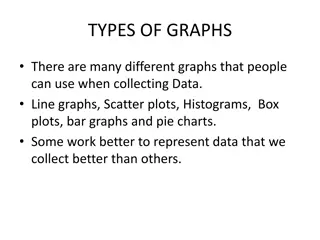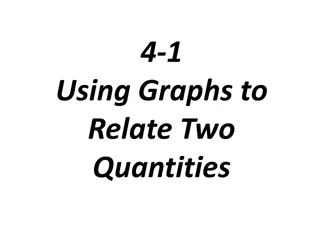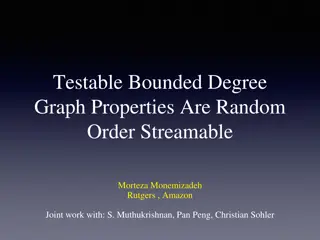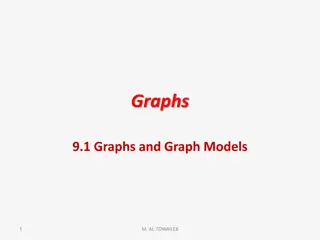Recent Developments in Testing Bounded-Degree Graphs
This article discusses recent advancements in testing bounded-degree graphs, including the introduction of the model, studies on graph isomorphism problems, and the development of testing algorithms. Key topics covered include the bounded-degree graph testing model, complexity analysis, and challenges related to graph isomorphism testing. The presentation slides provide insights into the work done in this field by researchers like Oded Goldreich and Dana.
Download Presentation

Please find below an Image/Link to download the presentation.
The content on the website is provided AS IS for your information and personal use only. It may not be sold, licensed, or shared on other websites without obtaining consent from the author.If you encounter any issues during the download, it is possible that the publisher has removed the file from their server.
You are allowed to download the files provided on this website for personal or commercial use, subject to the condition that they are used lawfully. All files are the property of their respective owners.
The content on the website is provided AS IS for your information and personal use only. It may not be sold, licensed, or shared on other websites without obtaining consent from the author.
E N D
Presentation Transcript
Recent Developments in Testing Bounded-Degree Graphs Oded Goldreich Weizmann Institute of Science Although Dana's recent focus has not been on this model, much of the pioneering work was done by her. This includes the introduction of the model, its initial study, and the celebrated tester for Bipartiteness, which relies on random walks. These slides https://www.wisdom.weizmann.ac.il/~oded/T/bdg24.pptx
Outline 1. 2. The bounded-degree graph testing model (G. and Ron, 1997). Studies of (the fixed graph and two graph versions of) the Graph Isomorphism problem, including determining the complexity of testing isomorphism to a fixed graph, for almost all regular graphs. Transporting hardness results about functions to hardness results about graphs by using robustly self-ordered graphs. E.g., a separation between tolerant and standard testing in the bounded-degree graph model (G. and Wigderson, 36th CCC, 2021). The work of Adler, Kohler and Peng (32nd SODA and 36th CCC, 2021), which is pivoted at constructing locally-characterized expander graphs. (The construction makes inherent use of the iterative and local nature of the Zig-Zag construction.) This yields a locally-characterizable graph property that cannot be tested within a number of queries that does not depend on the size of the graph. 3. 4.
The Bounded-Degree Graph model For a degree bound d, graphs are represented by incidence functions such that g(v,i) = w if w is the ithneighbor of v. On (explicit) input n and , a tester for property is given oracle access to g, representing G, and should satisfy: If G is in , then the tester accepts w.p at least 2/3 (or 1 ( one-sided )). If G is -far from , then the tester should reject w.p. at least 2/3, where G is -far from if for every G the symmetric difference between G and G is greater than dn/2. Focus: query complexity (as a function of n and ).
Testing Graph Isomorphism: The two-input-graphs version (The model has to be revised for two input oracles; alternatively pack two oracles in one.) THM: Testing requires query complexity (n2/3), n = #vertices. Proved by reduction to testing equality between (n/polylog n)-long sequences over [n], which in turn is closely related to testing equality between two distributions. (The tested pairs of graphs consists of polylog-sized connected components.) Open problem: What is the query complexity of this testing problem?
Testing Graph Isomorphism: The fixed fixed- -graph version [G. and Tauber] (This is a massively parameterized property; for a fixed n-vertex graph H, the question is whether the input graph G is isomorphic to H.) THM: Testing requires query complexity (n1/2). Furthermore, this holds for almost all d-regular n-vertex graphs H. THM: For almost all d-regular n-vertex graphs H, testing can be done in query complexity O(n1/2). Open problem: What about other graphs H? E.g., other there graphs H for which the query complexity is higher?
Robustly self Robustly self- -ordered graphs ordered graphs and transporting results from functions to graphs [G. and Wigderson] A self-ordered graph = asymmetric. (Recall: Focus on bounded-degree.) G=(V,E) is robustly self-ordered if for every permutation :V V with k non-fixed-points, G and (G) differ on (k) entries. G is locally self-ordered if given a vertex v in G isomorphic to G, we can find the location of v in G using polylog(|V|) queries to G . THM1 [GW]: There exists robustly and locally self-ordered graphs. Furthermore, they are strongly constructible. THM2 [GW]: If G is LSO and has polylog diameter, then given a vertex v in G, we can find its location in G using polylog(|V|) queries to G .
Robustly self-ordered graphs and transporting results from functions to graphs results from functions to graphs [G. and Wigderson] transporting THM3 [GW]: There exists a graph property that is easily testable but tolerantly testing it requires almost linear query complexity. (Recall: this is for the BDG model.) Proof idea: Start from an analogous result for properties of strings (obtained via PCPs by [FF]). Encode the bits of the (input) string by attaching tiny gadgets to a RSO and LSO graph (of Thm1). The RSO feature guarantees that the distance between strings is preserves (between the corres. graphs). Hardness of tolerant testing: Reduce (tolerantly) testing the string to (tolerantly) testing the graph, relying on the RSO feature. Easiness of standard testing: Reduce testing the graph to testing the corresponding string, using the LSO feature and Thm2.
Locally-characterized expander graphs [AKP] An n-vertex graph G is locally-characterized if it is uniquely determined (up to labeling) by a set of tuples of local conditions (i.e., all O(1)-neighborhoods should satisfy some prescribed condition). E.g., a graph consisting of isolated triangles is locally characterized. In contrast, typical expanders are not; the O(1)-neighborhoods in typical expanders are regular trees. THM: See title. Furthermore, they are strongly constructible. Proof idea: Superimpose a full D-ary tree with the Zig-Zag construction (of [RVW]), where D is the ``cloud size . This construction is locally characterizable.
Details re locally-characterized expander graphs Proof idea: Superimpose a full D-ary tree with the Zig-Zag construction (of [RVW]), where D is the ``cloud size . This construction is locally characterizable.
Lower bound on the query complexity of some locally-characterized properties [AKP, FPS] A graph property is locally-characterized if it can be expressed a set of tuples of local conditions. This extends the notions of induced and non-induced subgraph freeness. E.g., the set of regular graphs is characterized by asserting that every two vertices have the same number of neighbors. THM: There exist locally characterized graph properties that are not robustly locally-characterized. Furthermore, they are not testable within size-oblivious query complexity. Specifically, their query complexity is at least loglogloglog n. Proof idea: Use the locally characterized expander graphs. In contrast, by [FPS], every (infinite) property that is testable within size-oblivious query complexity contains a hyperfinite sub-property. A direct analysis gives a loglogloglog bound. (Can get log in a relaxed model )
References For the two-graph version of the Graph Isomorphism: Testing Isomorphism in the Bounded-Degree Graph Model, ECCC TR19-102, 2019. For the fixed graph version of the Graph Isomorphism: G. and Tauber, On Testing Isomorphism to a Fixed Graph in the Bounded-Degree Graph Model, ECCC TR23-146, 2023. For transporting results about functions to results about graphs by using robustly self-ordered graphs: G. and Wigderson, Robustly Self-Ordered Graphs: Constructions and Applications to Property Testing, in 36th CCC (2021) and TheoretiCS, Vol. 1, Art. 1, 2022. For constructing locally-characterized expander graphs and their use for lower bounds on the query complexity of testing a locally-characterizable graph property: * On locally-characterized expander graphs (a survey), ECCC TR24-013, 2024. * On the query complexity of testing local graph properties in the bounded-degree graph model, ECCC TR24-047, 2024. These slides https://www.wisdom.weizmann.ac.il/~oded/T/bdg24.pptx









